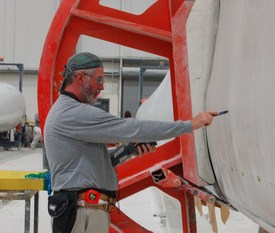
EBENSBURG, Pa. — As the G-20 Summit prepares to open in Pittsburgh Sept. 24 to deal with global capitalism’s severe economic crisis, labor journalists from the International Labor Communicators Association visited some 15 area work sites to investigate the economic conditions for working people here in western Pennsylvania.
Four ILCA journalists traveled to a wind turbine plant in Cambria County, steel and coal country in the Alleghenies, near Johnstown, Pa. Driving through the winding mountain roads you see giant windmills standing side by side with the Allegheny forests and farms. A wind farm is growing in Pennsylvania.
Formerly laid-off workers in this economically hard hit area are building the blades that catch the wind to generate 2 percent of the state’s electricity. While coal generates some 50-60 percent, alternative energy from wind is finding its place on the transmission grid along with the region’s economy and culture.
“This is a feel good job. You are helping out the economy, the environment and leaving a better legacy for our children,” says Troy Galloway, the 46-year-old past president of United Steelworkers Local 2635, which represents the workers at Gamesa. Gamesa is a Spain-based company, which invested in Pennsylvania and now employs 800 workers in the state.
Galloway has been working for Gamesa for the last three years after being laid-off from a local foundry/machine shop where he had worked for 15 years. He has appeared in an ABC News feature “Rust Belt Is Going Green,” a YouTube video, “Made In America: New Energy, New Jobs” and the United Steelworkers magazine, USW@Work. Galloway has become the face of a movement to increase alternative energy jobs as a way to revitalize manufacturing and communities hit hard by years of de-industrialization and the current economic crisis, while at the same time reducing “dependence on foreign oil.”
Gamesa chose Pennsylvania because the state government committed to producing 18 percent of its energy from alternative sources by 2020. After coal, hydro and nuclear are the next big sources of power. Wind is now at 2 percent up from practically zero five years ago. The state agreed to buy wind power generated by Gamesa developments.
“I see everyday the fruits of my labor,” Galloway says. He drives past the Allegheny Ridge Wind Farm on his way to and from work, which uses the Gamesa blades on its turbines. Galloway says he used to recycle before the job, but since being hired at Gamesa he thinks more about the environment and “what we can do for Mother Earth.”
The base pay at Games is $13.11 and goes up to $25 an hour. Employees get health care coverage and there is a safety committee. There are 235 union employees at the plant. “Union jobs are the best jobs,” Galloway says.
Gamesa won an award from the non-profit American Rights At Work for remaining neutral during the union’s organizing drive. These jobs have a “trickle down effect,” he says, creating more jobs, from the needed uniforms to local businesses.
But the large scale employment that steel mills once provided — in the Ebensburg area alone more than 10,000 steelworkers once lived, toiled and raised families — is still illusive. But with “labor-saving” technology it seems that massive employment at a single manufacturing facility is over. Although Gamesa seeks to help build up U.S.-based supply chain for wind turbines there is no such production here. Some 8,000 parts go into a turbine. CNC machines used in wind turbine production are made in Europe.
Yet a new political and economic movement in the United States wants to change that. Called the green jobs movement, it projects creating 5 million jobs with $500 billion over next 10 years with investment in clean energy. Economists says at least 122,000 jobs per month have to be added to take care of the people coming into the job market before the high unemployment can begin to decrease. In July, 247,000 jobs were lost.
But shifting the economy from a fossil-fuel, high finance-based economy to an alternative energy, good manufacturing-based economy takes a political agenda as well. President Obama’s stimulus package, which is designed to save or create 3 million jobs, takes a step in that direction. It offers a 30 percent grant if a company buys wind turbines as a way to encourage alternative energy investment and create jobs in this sector. “So if they spend $1 million they’ll get $300,000 from the government,” says Galloway.
When you read the business press hyping the corporate gods of the G-20 Summit, Pittsburgh is a role model for transforming an “old steel town” to a pioneer in the “new economy” of biomedical technology, health care, robotics and nuclear energy. Some 100 multi-billion-dollar corporations are located in Pittsburgh, including Alcoa, ANSYS, Heinz, PPG and Westinghouse. Yet they don’t mention that in many of these industries wages are low and can never replace the types of manufacturing jobs that created the famed American “middle class.” And, of course, not a word of the complex financial wheelings and dealings and its twin the exploded housing bubble that have brought the global economy to a halt.
But to turn around such an economy takes a political movement, as well as cultural changes. In coal country, where energy and timber companies have stripped and ripped off the land and people, energy companies — even “green energy and green jobs” type of companies like Gamesa have historic memory to overcome. There is some local resistance to the wind farm being built along the ridges of the Alleghenies. Supporter of green jobs and wind farms are mobilized to go to the town hall meetings to counter the opposition.
Workers at Gamesa reflect a growing consciousness among the area people, and working- class communities as a whole, about combining the necessity of reducing carbon output to slow global warming and creating good jobs for hard hit, de-industrialized communities. Leigh Straw, crew leader of Gamesa’s Root Department, sees a future in the green energy field.
Experiencing ups and downs in his cabinet-installation job, Straw says this industry has the potential to stay around for the “long haul.” Since working at Gamesa he recycles more and watches the energy use in his house. Straw also enjoys the job and responsibilities, including the cross-training program which means that workers learn jobs in other departments. The variation of the work day and the “economic incentive” don’t hurt either, he says.
After working for a food service company, Dan Disabato went through a lay-off after the company went bankrupt. Chair of the Safety Committee, Disabato also sees global warming “in a different light.”
“This job is something good for me and for the U.S.,” Disabato says. He always had concerns about “dependence on foreign oil.”
“Gas prices,” he says.
Walking through the factory, there is a faint paint-like smell. You can tell it’s a dusty job but the air wasn’t thick with the fiberglass particles. Workers wore protective masks. Disabata just came back from an OSHA training. “There is potential for accidents but the company works well with us, getting us the protective equipment we need.” The biggest complaints? “Sore backs and feet from standing on concrete all day,” he says.
The early stage of the blade production is a lot like watching taffy being pulled and cooked. In fact, there are many ovens in the plant that work to harden the materials. A new-type of blade is being developed after a previous model splintered and broke. Other improvements include ways to discourage mass bird and bat deaths after they fly into the rotating blades.
While driving through these seemingly serene mountains and valleys dotted with the modern windmills, it becomes clearer that the road to a green job economy is as winding as the highway and as necessary as the journey.










